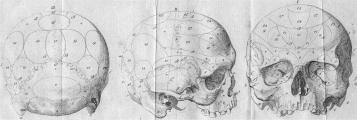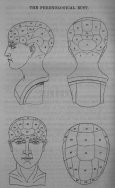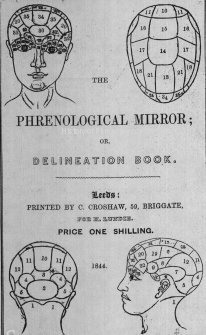This page provides lists of the phrenological organs
and faculties according to Gall, Spurzheim and later British phrenologists.
For an explanation of the the faculties/organs see the overview
and the primary phrenology texts.
Gall's original 27 faculties/organs
List of organs from Spurzheim's Physiognomical System (1815)
The phrenological organs according to George Combe (lists from 1834 & 1847) [Full descriptions and images of many are available through this list]
Terms used to differentiate the sizes of organs according to Combe
The phrenological organs according to H. Lundie (1844)
See also: Other Lists on the Web
Gall's cerebral organs carried the names of their supposed functions or faculties and were numbered: (the German & French are original- the English is a translation)
|
1. impulse to propagation (Zeugungstrieb, Fortpflanzung; Instinct de la génération, de la reproduction, de la propagation); |
15. faculty of language (Sprachsinn, Sprach-Forschungs-sinn; sens de langage, Talent de la philologie); |
|
2. Tenderness for the offspring, or parental love (Jungenliebe, Kinderliebe; Amour de la progéniture); |
16. disposition for colouring, and the delighting in colours (Farbensinn; sens des rapports de couleurs); |
|
3. friendly attachment or fidelity (Anhänglichkeit, Freundschaftsinn; Attachement, amitié); |
17. sense for sounds, musical talent (Tonsinn, Musiktalent; Talent de la musique, sens des rapport des tons); |
|
4. valour, self-defense (Mut, Raufsinn, Selbstverteidigungsinstinkt; Instinct de la défense de soi-même et de sa propriété); |
18. arithmetic, counting, time (Zahlensinn, Zeitsinn; Sens des rapports des nombres); |
|
5. murder, carnivorousness (Mord/Würgsinn; Instinct carnassier); |
19. mechanical skill (Kunstsinn, Bausinn; Sens de mécanique, de construction, Talent de l'architecture); |
|
6. sense of cunning (Schlauheitssinn, List; ruse); |
20. comparative perspicuity, sagacity (vergleichender Scharfsinnorgan; Sagacité comparative); |
|
7. larceny, sense of property (Diebessinn, Eigenthumsinn; Sentiment de la propriété); |
21. metaphysical perspicuity (Metaphysischer-Tiefsinn; Esprit métaphysique, profondeur d'esprit); |
|
8. pride, arrogance, love of authority (Stolz, Hochmut, Herrschsucht; Orgueil, fierté, hauteur); |
22. wit, causality, sense of inference (Witz, Causalität, Folgerungsvermögen; Esprit caustique); |
|
9. ambition and vanity (Eitelkeit, Ruhmsucht, Ehrgeiz; Vanité, ambition, amour de la gloire); |
23. poetic talent (Dichtergeist; Talent poétique); |
|
10. circumspection (Behutsamkeit, Vorsicht, Vorsichtigkeit; Circonspection); |
24. Good-nature, compassion, moral sense (Gutmüthigkeit, Mitleiden, moralischer Sinn; Bonté, compassion, douceur); |
|
11. aptness to receive an education, or the memoria realis (Erziehungs-Fähigkeit, Sachsinn, Sachgedächtnis; mémoire des choses et des faits, perfectibilité); |
25. Mimic (Nachahmungssinn; Faculté d'imiter, mimique) |
|
12. sense of locality (Ortsinn, Raumsinn; Sens des localités); |
26. Theosophy, sense of God and religion (Organ der Theosophie, Sinn für Gott und die Religion; Sentiment religieux); |
|
13. recollection of persons (Personensinn; mémoire des personnes); |
27. Perseverance, firmness (Organ der Festigkeit, Beständigkeit; Fermeté, constance, persévérance). |
|
14. faculty for words, verbal memory (Wortsinn, Wort-Gedächniss; sens des mots, mémoire verbale); |
|
[See also Combe's rendition of Gall's list]
Gall's organ names varied and several were generally given, unlike the singular names later used by Spurzheim and the phrenologists. Gall meant to express his inexact understanding of the functions of the organs by using multiple terms and he did not approve of the certainty presumed by Spurzheim in using single terms. I have tried to reflect the variety of terms used by collating contemporary lists. The English translations are partly from: Dr. F .J. Gall's system of the functions of the brain extracted from Charles Augustus Blöde's, account of Dr. Gall's lectures, held on the abore[sic] subject at Dresden. n.p., 1807, to preserve a contemporary flavour; with my own additions. The French names are Gall's own after he settled in Paris (1807-1828). Gall never recognized additional organs beyond these twenty-seven.
-The following list of Gall's organs is from K.A.
Blöde, Dr. F. J. Gall's Lehre über die Verrichtungen des Gehirns,
nach dessen Dresden gehaltenen Vorlesungen in einer fasslichen Ordnung mit
gewissenhafter Treue dargestellt. Dresden, 2nd ed. 1806.* Note that
the numbers of the organs are different from the above list.
1 Das Organ des Geschlechtstriebes
2 Das Organ der Kinder-oder Jungenliebe
3 Das Organ der Erziehungsfähigkeit, Memoria
realis
4 Die Organe des Ortsinns
5 Das Organ des Personensinns (in der Augenhöle)
6 Das Organ des Farbensinns
7 Das Organ des Tonnsinns
8 Das Organ des Zahlensinns
9 Das Organ des Wortsinns (in der Augenhöle)
10 Das Organ des Sprachsinns
11 Das Organ des Kunstsinns
12 Das Organ der Freundschaft und Anhänglichkeit
13 Die Organe des Raufssinns
14 Das Organ des Mordsinns
15 Das Organ des Schlauheit
16 Das Organ des Diebsinns
17 Das Organ des Höhesinns
18 Die Organe der Ruhmsucht u. Eitelkeit
19 Die Organe der Bedächtlichkeit
20 Das Organ des vergleichenden Scharfssinns
21 Das Organ des philosophischen Scharfssinns (schließt die Organe
Nr. 20. mit ein)
22 Die Organe des Witzes
23 Das Organ des Induktionsvermögens (schließt die Organe Nr.
20. 21. u. 22. mit ein)
24 Das Organ der Gemüthigkeit
25 Das Organ der Theosophie
26 Das Organ der Festigkeit
27 Das Organ der Darstellungsgabe (schließt Nr. 24 mit ein)
Spurzheim first arranged Gall's organs in a taxonomic hierarchy and added
additional organs bringing the total to thirty-two.
I. Organ of amativeness (physical love).
[physical love dropped in 2nd edition]
II. -- philoprogenitiveness, (love of offspring).
III. -- inhabitiveness. [has a "?" in 2nd]
IV. -- adhesiveness.
V. -- combativeness.
VI. -- destructiveness.
VII. -- constructiveness.
VIII. -- covetiveness.
IX. -- secretiveness.
X. -- self-love.
XI. -- approbation. [changed to love of approbation in 2nd ed]
XII. -- cautiousness.
XIII. -- benevolence.
XIV. -- veneration.
XV. -- hope.
XVI. -- ideality.
XVII. -- conscientiousness.
XVIII. -- firmness or determinateness [2nd word dropped in 2nd ed]
XIX. -- individuality.
XX. -- form.
XXI. -- size [has a "?" in 2nd]
XXII. -- weight ["and momenta?" added after weight in 2nd]
XXIII. -- colour [colouring in 2nd ed]
XXIV. -- space. [changed to locality in 2nd ed]
XXV. -- order?
XXVI. -- time?
XXVII. -- number.
XXVIII. -- tune.
XXIX. -- language.
XXX. -- comparison.
XXXI. -- causality.
XXXII. -- wit.
XXXIII. -- imitation.
 This
list is taken from Combe's Constitution of
Man. Click on an organ name and view the description from Combe's
System of Phrenology. You can
find where each organ is located and phrenologize on your very own by comparing
these descriptions with the engraving below. Combe's list formed the basis
for almost all later phrenologists throughout the century.
This
list is taken from Combe's Constitution of
Man. Click on an organ name and view the description from Combe's
System of Phrenology. You can
find where each organ is located and phrenologize on your very own by comparing
these descriptions with the engraving below. Combe's list formed the basis
for almost all later phrenologists throughout the century.
THE LOVE OF LIFE.-Organ not indicated on the bust.
1. AMATIVENESS-Produces sexual love.
2. PHILOPROGENITIVENESS.- Uses: Affection for young and tender beings.-Abuses: Pampering and spoiling children.
3. CONCENTRATIVENESS.-Uses: It concentrates and renders permanent emotions and ideas in the mind.- Abuses: Morbid dwelling on internal emotions and ideas, to the neglect of external impressions.
3a. INHABITIVENESS.-Uses: It produces the desire of permanence in place.-Abuses: Aversion to move abroad.
4. ADHESIVENESS.-Uses: Attachment friendship and society result from it.-Abuses: Clanship for improper objects, attachment to worthless individuals. It is generally strong in women.
5. COMBATIVENESS.- Uses: Courage to meet danger and overcome difficulties, tendency to defend, to oppose and attack, and to resist unjust encroachments.-Abuses: Love of contention, and tendency to provoke and assault. This feeling obviously adapts man to a world in which danger and difficulty abound.
6. DESTRUCTIVENESS.-Uses: Desire to destroy noxious objects, animate and inanimate, and to use for food animals in which life has been destroyed.-Abuses: Cruelty, murder, desire to torment, tendency to passion, rage, and harshness and severity in speech and writing. This feeling places man in harmony with death and destruction, which are woven into the system of sublunary creation.
6a. APPETITE FOR FOOD.- Uses: Nutrition.-Abuses: Gluttony and drunkenness.
7. SECRETIVENESS.-Uses: Tendency to restrain-with-in the mind the various emotions and ideas that involuntarily present themselves, until the judgement has approved of giving them utterance; it is simply the propensity to conceal, and is an ingredient in prudence. Abuses: Cunning, deceit, duplicity, and lying.
8. ACQUISITIVENESS.-Uses: Desire to possess, and tendency to accumulate; the sense of property springs from it.-Abuses: Inordinate desire of property, selfishness, avarice, theft.
9. CONSTRUCTIVENESS.-Uses: Desire to build and construct works of art.-Abuses: Construction of engines to injure or destroy, and fabrication of objects to deceive mankind.
Genus II. SENTIMENTS. I. Sentiments common to Man with some of the Lower Animals.
10. SELF-ESTEEM.-Uses: Self-respect, self-interest, love of independence, personal dignity.-Abuses: Pride, disdain, overweening conceit, excessive selfishness, love of dominion.
11. LOVE OF APPROBATION.-Uses: Desire of the esteem of others, love of praise, desire of fame or glory.-Abuses: Vanity, ambition, thirst for praise independently of praiseworthiness.
12. CAUTIOUSNESS.-Uses: It gives origin to the sentiment of fear, the desire to shun danger, and circumspection ; and it is an ingredient in prudence. The sense of security springs from its gratification.-Abuses: Excessive timidity, poltroonery, unfounded apprehensions, despondency, melancholy.
13. BENEVOLENCE-Uses: Desire of the happiness of others, compassion for the distressed, universal charity, mildness of disposition, and a lively sympathy with the enjoyment of all animated beings.-Abuses: Profusion, injurious indulgence of the appetites and fancies of others, prodigality, facility of temper.
II. Sentiments Proper to Man.
14. VENERATION.-Uses: Tendency to venerate or respect whatever is great and good; it gives origin to religious emotion-Abuses: Senseless respect for unworthy objects consecrated by time or situation, love of antiquated customs, abject subserviency to persons in authority, superstitious awe. To these Mr Scott adds, "undue deference to the opinions and reasonings of men who are fallible like ourselves; the worship of false gods, polytheism, paganism, idolatry."
15. FIRMNESS.-Uses: Determination, perseverance, steadiness of purpose.-Abuses: Stubbornness, infatuation, tenacity in evil.
16. CONSCIENTIOUSNESS.-Uses: It gives origin to the sentiment of justice, a respect for rights, openness to conviction, the love of truth.-Abuses: Scrupulous adherence to noxious principles when ignorantly embraced, excessive refinement in the views of duty and obligation, excess in remorse or self-condemnation.
17. HOPE-Uses: Tendency to expect future good it cherishes faith.-Abuses: Credulity with respect to the attainment of what is desired, absurd expectations of felicity not founded on reason.
18. WONDER.-Uses: The desire of novelty; admiration of the new, the unexpected, the grand, the wonderful, and extraordinary.-Abuses: Love of the marvellous and occult ; senseless astonishment ; belief in false miracles, in prodigies, magic, ghosts, and other supernatural absurdities.-Note. Veneration, Hope, and Wonder, combined, give origin to religion; their abuses produce superstition.
19. IDEALITY.-Uses: Love of the beautiful, desire of excellence, poetic feeling.-Abuses: Extravagant and absurd enthusiasm, preference of the showy and glaring to the solid and useful, a tendency to dwell in the regions of fancy and to neglect the duties of life.
19a. Unascertained, supposed to be connected with the sentiment of the Sublime.
20. WIT-Gives the feeling of the ludicrous, and disposes to mirth.
21. IMITATION-Copies the manners, gestures, and actions of others, and appearances in nature generally.
Order II. INTELLECTUAL FACULTIES.
Genus I. EXTERNAL SENSES.
Uses: To bring man into communication with external objects, and to enable him to enjoy them.-Abuses: Excessive indulgence in the pleasures arising from the senses, to the extent of impairing bodily health, and debilitating or deteriorating the mind.
FEELING or TOUCH. TASTE. SMELL. HEARING. SIGHT.
Genus II. KNOWING FACULTIES WHICH PERCEIVE THE EXISTENCE AND QUALITIES OF EXTERNAL OBJECTS
22. INDIVIDUALITY-Takes cognizance of existence and simple facts.
23. FORM-Renders man observant of form.
24. SIZE-Gives the idea of space, and enables us to appreciate dimension and distance.
25. WEIGHT-Communicates the perception of momentum, weight, and resistance; and aids equilibrium.
26. COLOURING-Gives perception of colours, their harmonies and discords.
Genus III. KNOWING FACULTIES WHICH PERCEIVE THE RELATIONS OF EXTERNAL OBJECTS
27. LOCALITY-Gives the idea of relative position.
28. NUMBER-Gives the talent for calculation.
29. ORDER-Communicates the love of physical arrangement.
30. EVENTUALITY-Takes cognizance of occurrences or events.
31. TIME-Gives rise to time perception of duration.
32. TUNE.-The sense of Melody and Harmony arises from it.
33. LANGUAGE-Gives facility in acquiring a knowledge of arbitrary signs to express thoughts, readiness in the use of them, and the power of inventing and recollecting them.
Genus IV. REFLECTING FACULTIES, WHICH COMPARE, JUDGE, AND DISCRIMINATE.
34. COMPARISON-Gives the power of discovering analogies, resemblances, and differences.
35. CAUSALITY-Traces the dependences of phenomena, and the relation of cause and effect.
Modes of actions of the faculties
"The observer should learn, by inspecting a skull,
to distinguish the mastoid process behind the ear, and several bony prominences
which occur in every head, from elevations produced by development of brain;
as also to discriminate bony excrescences sometimes formed by the sutures,
when such occur. The terms used to denote the gradations of size in the
different organs, in an increasing ration, are
Very small, Small, Rather small, Moderate,
Rather full, Full, Rather large, Large, Very large" G.
Combe Elements
of Phrenology.
The following list of 39 organs is taken from H. Lundie, The
Phrenological Mirror; or, Delineation Book (Leeds, 1844),
and is the same as those used by George Combe and the Edinburgh phrenologists
with the exception of the "newly discovered organs" which Combe did not
recognize as established.
|
Order 1st.-Feelings. Genus 1st. Propensities. |
20. Wit |
|
1. Amativeness |
21. Imitation |
|
2. Philoprogenitiveness |
Order 2nd. Genus 1st.-Intellectual Faculties which perceive existence and physical qualities. |
|
3. Concentrativeness |
22. Individuality |
|
4. Adhesiveness |
23. Form |
|
5. Combativeness |
24. Size |
|
6. Destructiveness |
25. Weight |
|
Alimentiveness |
26. Colour |
|
7. Secretiveness |
27. Locality |
|
8. Acquisitiveness |
28. Number |
|
9. Constructiveness |
29. Order |
|
Genus 2nd.-Inferior Sentiments. |
30. Eventuality |
|
10. Self-Esteem |
31. Time |
|
11. Love of Approbation |
32. Tune |
|
12. Cautiousness |
33. Language |
|
Genus 3rd.-Superior Sentiments. |
Genus 2nd.-Reflective Faculties. |
|
13. Benevolence |
34. Comparision |
|
14. Veneration |
35. Causality |
|
15. Firmness |
Newly Discovered Organs. |
|
16. Conscientousness |
36. Independence |
|
17. Hope |
37. Comicality |
|
18. Wonder |
38. Velocity |
|
19. Ideality |
39. Grotesque |
-Spurzheim, Outlines
of Phrenology; being also a manual of reference for the marked busts.
London, 1827. [Illustrated html]
-Spurzheim, Phrenology:
or the doctrine of the mental phenomena. Philadelphia, 1908. [A
late edition of The physiognomical System 1815. Illustrated html]
-Combe, A system of phrenology, 1853, Appendices
3 & 4.
-The organs according to Samuel
R. Wells, after O.S. Fowler (n.d.) about 40
organs delineated. At the 'Phrenology and the Fine Arts' site.
-Combe, Elements
of Phrenology (American ed.1834) by Peter Friesen.
-Two lists are opposed in Physiognomy:
founded on Physiology (London, 1834) by Alexander Walker, at
Ross Woodrow's physiognomy site. (Includes images of two bust engravings.)
-Fossati, Dr. Jean, Antoine Laurent, Manuel
pratique de Phrénologie ou physiologie du cerveau d'après les
doctrines de Gall, de Spurzheim, de Comte et des autres phrénologistes (Paris,
1845). See a more easily viewed digitization of Fossati's organ list
at Marc
Renneville's site.
See also: Time line of phrenology.
and
Donovan's A Handbook of Phrenology (1870) for a more detailed description and illustrations for head reading.
* I am grateful to Wolfgang Schütz for lending me an original copy of Blöde's work.
© John van Wyhe 1999-2011. Materials on this website may not be reproduced without permission except for use in teaching or non-published presentations, papers/theses.